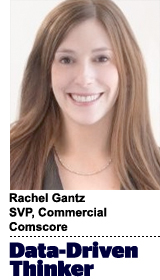
“Data-Driven Thinking” is written by members of the media community and contains fresh ideas on the digital revolution in media.
Today’s column is written by Rachel Gantz, SVP, commercial, at Comscore.
Time’s up. #MeToo. Equal pay. This is the world many of us proudly live in.
Gender identity and norms have become more fluid and expansive – and they are often at the forefront of discussions across industries.
As a participant in the advertising ecosystem, I believe that today’s environment begs the question: Is advertising doing its part to keep up with the gender conversation? Isn’t advertising supposed to be aspirational and fill the needs we don’t even know we have? How can a successful ad guide me to my next car, or help me select my next roll of paper towels if it doesn’t reflect our modern-day collective experience?
As brands look to adapt to today’s environment and pivot their businesses to engage the next generation, it has become critically important to understand shifts in gender constructs and identity.
Thirty-five percent of Generation Z says they personally know someone who uses gender-neutral pronouns like “they” and “them,” according to Pew Center of Research, compared to 25%, 16% and 12% percent for millennials, Generation X and baby boomers, respectively.
There has been much discussion about inclusive creatives and how gender should be represented or depicted in advertisements. But what about the data used to target those creatives? How can brands refine their targeting strategies to effectively reach audiences in this new era?
And furthermore, what does this mean for data providers? What responsibility do data providers bear to help move the conversation forward?
Inclusivity in ad targeting
While gender constructs are certainly evolving as a whole, it’s clear that the advertising industry isn’t quite ready to retire basic demographic targeting, and there are several examples we can point to as evidence. Comscore data shows, for example, that 88% of consumers shopping for a BMW X7 are male, and 73% of buyers of baby goods are female.
Demographic targeting – at least today – is far from irrelevant, and for some goods it continues to be an important part of a successful ad targeting strategy. However, it’s imperative for brands to recognize today’s rapidly-changing world and that consumers are no longer defined solely by their age and gender; they’re a collection of interests, preferences, behaviors and affinities.
Saying goodbye to outdated stereotypes
Already, we see emerging trends that defy traditional stereotypes. Per Comscore data:
- Only 55% of video game console and accessory buyers are male, defying the accepted thinking that gamers and the surrounding markets are nearly all men.
- Forty-one percent of visitors to sports sites are female, even though the common perception is that men consume most sports content.
- Nearly half of social media site visitors are older than 45, despite conventional wisdom that younger generations are power users of social media.
If you’re targeting based on assumptions and preconceived notions, you’re likely missing out on a large group of in-market, high-value consumers. At best, this simply results in wasted spend. At worst, mistargeted creatives could annoy and even offend particular groups, possibly damaging a brand.
It’s clear that the currency of decades past is no longer sufficient in today’s climate. Brands, agencies and data providers must pivot quickly to a more comprehensive, advanced and inclusive set of targeting criteria.
The targeting for many industries must go beyond age and gender. The advancement of behavioral-based targeting audiences furthers this cause and deserves more buy-side attention.
But how can brands and agencies do that successfully when they are faced with hundreds of demographic data providers and thousands of targetable audiences in any DSP or DMP? Blaming brands and agencies for not digging in deeper on what data they use and settling for cheap alternatives is easy, but it’s just as much on data providers to hold themselves to a better standard.
Inclusivity and quality amid targeting clutter
Our industry is undergoing a reckoning of purging low-quality targeting data (finally). Recently, Oracle Data Cloud announced a set of premium data partners (Disclosure: Comscore is included). Even the Interactive Advertising Bureau is getting involved, as evidenced by their new data label initiative. This is critical not only for the betterment of the industry but is also a key driver for more inclusive advertising.
While these are important first steps, more is needed.
If a brand wants to target a baseball fan, it should be able to target a baseball fan, and not just a man (this from an avid female sports fan).
When our family and friends ask what we do for a living, instead of saying “we keep the internet free,” perhaps it’s time to say, “We keep it free, relevant – and, most importantly – inclusive.”
Follow Comscore (@Comscore) and AdExchanger (@adexchanger) on Twitter.
This post was syndicated from Ad Exchanger.


More Stories
Warner Bros. Discovery CEO David Zaslav Receives $51.9 Million Pay Package for 2024
TikTok Fave Duolingo Boosts YouTube Shorts Viewership 430% in One Year
Streaming Ratings, Week of March 10: Disney+ Sails to the Top Courtesy of Moana 2